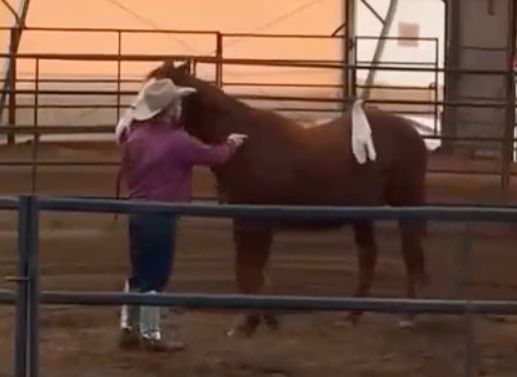Continuing on from my last post, where I talked about reminding a horse how to soften to the feel of the lead rope and soften when there is a proactive pressure introduced, I now want to carry the idea of softness through the horse’s entire body before I think of moving forward with riding or training.

In Relational Horsemanship, touching the horse with the flag is not a way to “sack out” or “desensitize” the horse, but is a way to help him remember how to think through pressure and relax, rather than simply react and become braced in his body. (Video clip from webinar on “Bringing a Horse Back After Time Off”, available in our online program at JoshNichol.com)
One of the first things I will do at this point is check in with how the horse responds to the touch of my flag on various parts of his body. I want to see that touching him on his legs, sides, belly, etc. does not cause him to brace. If it does, it is better to find this out before you get on and discover that some sensation he feels while you’re sitting on him is making him worry.
When I’m touching him at any point and I feel or see him brace, I will once again put a light feel on my lead and ask him to soften, then take the touch of the flag away immediately when he does. I will also ask him to move his feet and walk with me a little bit, then go through the touching again, as this often helps the horse to relax. If you just make them stand and keep touching them, they can start to freeze up or feel stuck.
A point I want to emphasize here is that when I touch a horse with a flag like I just described, I am not “sacking him out” or “desensitizing” him. Those techniques usually involve the repeated application of a pressure until the horse figures out that he can’t escape it and therefore just stands there and tolerates it. There is nothing relational in such methods, which tend to disconnect the horse from you rather than connect him to you. Helping a horse learn to actually soften when a pressure is making contact increases his trust in you and instills self-confidence in the horse, both of which are valuable building blocks for your relationship.
Once I see that the horse can stay relaxed being touched, I will start engaging him in some spatial interactions — asking him to yield different parts of his body, as always looking for softness in the yield, not just a physical movement — and I’m also going to begin upping my pressure to a degree. I want to remind him that he can handle greater challenges and still maintain his peace of mind, as the real world presents many challenges for a horse and rider, and the only way to stay safe is to show your horse how to stay calm in such situations.

In general, when a horse comes back after time off, they are often up energetically, like this youngster. That is why we need to feel the lead and sense where the horse is at. What you sense there will help you decide what to do next, e.g. turn the horse loose, stay on the line, etc.
If your horse had some solidity in his training prior to the layoff, you will usually find that the horse comes back to understanding what you are asking quite quickly. However, it is not unusual for the horse to be a bit “up” energetically when you first bring them in and start playing with these things again. This is especially true if the horse is a youngster.
So, keep in mind that when you do the very first step we talked about in my previous post, asking the horse to soften his top line while standing, you are really using the lead to feel the mind of the horse and see where he is at. If the feel you get is one of barely contained energy, the best course of action might be to turn the horse loose and allow him the movement he needs to come down to an energetic level where he is able to focus.
If you sense that the horse wants to engage you spatially (perhaps nibbling on the line, nipping at your hand, or stepping into your space), you may need to have the spatial conversation the horse is asking for before trying to work on anything else. Remember that a Space horse’s attempts to engage you are not “rude” or “dominant”. The horse is simply asking for clarification in your relationship, wanting to know who is going to handle whatever concerns he may need to think about. It is quite common for a Space horse to ask this question again after time off, but have faith that whatever training you had put in there before is still there, and most likely you’ll both find it again pretty quickly.

Thank you Josh! Simple yet clear, and a great reminder!
Perfect timing Josh. Thanks for all these reminders.
Great reminders as I am just starting to ride a horse I have not ridden for 3 month.
Thank you, this is so timely for me to resume work with the “Cob girls.” The surgeon has given ME clearance to resume all activities after my total knee replacement 3 months ago! They have been wild hooligans begging for attention. Dolly
I love that comment about “who is going to handle whatever concerns he may need to think about”! It is so true with a space horse and once you let go of the thought that they are being rude, they are actually quite funny in their attempts to engage.
Thank you